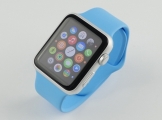|
我创建了一个自定义数据网格。它基于具有自定义布局的 Collection View 。布局修改了第一个部分和行属性,使其具有粘性,因此当用户滚动其他行和部分时,应该位于粘性的下方。这种布局的想法不是我的,我只是采用了它。 (我不能把功劳归于真正的创作者,在我的研究中,我发现了太多的布局变化,我不确定哪个是原始的。)。
不幸的是,我遇到了一个问题。滚动时我遇到了崩溃:
*** Terminating app due to uncaught exception 'NSInternalInconsistencyException', reason: 'no
UICollectionViewLayoutAttributes instance for
-layoutAttributesForItemAtIndexPath:
尽管有消息,但我认为真正的问题在于 layoutAttributesForElements 方法。我读过一些有类似问题的线程,但唯一可行的解决方案是返回所有缓存的属性,无论传递的矩形如何。我只是不喜欢这样快速而肮脏的解决方案。我真的很感激你能给我的任何想法/解决方案。
整个项目是here .然而最重要的是布局,所以为了方便,这里是:
class GridViewLayout: UICollectionViewLayout {
//MARK: - Setup
private var isInitialized: Bool = false
//MARK: - Attributes
var attributesList: [[UICollectionViewLayoutAttributes]] = []
//MARK: - Size
private static let defaultGridViewItemHeight: CGFloat = 47
private static let defaultGridViewItemWidth: CGFloat = 160
static let defaultGridViewRowHeaderWidth: CGFloat = 200
static let defaultGridViewColumnHeaderHeight: CGFloat = 80
static let defaultGridViewItemSize: CGSize =
CGSize(width: defaultGridViewItemWidth, height: defaultGridViewItemHeight)
// This is regular cell size
var itemSize: CGSize = defaultGridViewItemSize
// Row Header Size
var rowHeaderSize: CGSize =
CGSize(width: defaultGridViewRowHeaderWidth, height: defaultGridViewItemHeight)
// Column Header Size
var columnHeaderSize: CGSize =
CGSize(width: defaultGridViewItemWidth, height: defaultGridViewColumnHeaderHeight)
var contentSize : CGSize!
//MARK: - Layout
private var columnsCount: Int = 0
private var rowsCount: Int = 0
private var includesRowHeader: Bool = false
private var includesColumnHeader: Bool = false
override func prepare() {
super.prepare()
rowsCount = collectionView!.numberOfSections
if rowsCount == 0 { return }
columnsCount = collectionView!.numberOfItems(inSection: 0)
// make header row and header column sticky if needed
if self.attributesList.count > 0 {
for section in 0..<rowsCount {
for index in 0..<columnsCount {
if section != 0 && index != 0 {
continue
}
let attributes : UICollectionViewLayoutAttributes =
layoutAttributesForItem(at: IndexPath(forRow: section, inColumn: index))!
if includesColumnHeader && section == 0 {
var frame = attributes.frame
frame.origin.y = collectionView!.contentOffset.y
attributes.frame = frame
}
if includesRowHeader && index == 0 {
var frame = attributes.frame
frame.origin.x = collectionView!.contentOffset.x
attributes.frame = frame
}
}
}
return // no need for futher calculations
}
// Read once from delegate
if !isInitialized {
if let delegate = collectionView!.delegate as? UICollectionViewDelegateGridLayout {
// Calculate Item Sizes
let indexPath = IndexPath(forRow: 0, inColumn: 0)
let _itemSize = delegate.collectionView(collectionView!,
layout: self,
sizeForItemAt: indexPath)
let width = delegate.rowHeaderWidth(in: collectionView!,
layout: self)
let _rowHeaderSize = CGSize(width: width, height: _itemSize.height)
let height = delegate.columnHeaderHeight(in: collectionView!,
layout: self)
let _columnHeaderSize = CGSize(width: _itemSize.width, height: height)
if !__CGSizeEqualToSize(_itemSize, itemSize) {
itemSize = _itemSize
}
if !__CGSizeEqualToSize(_rowHeaderSize, rowHeaderSize) {
rowHeaderSize = _rowHeaderSize
}
if !__CGSizeEqualToSize(_columnHeaderSize, columnHeaderSize) {
columnHeaderSize = _columnHeaderSize
}
// Should enable sticky row and column headers
includesRowHeader = delegate.shouldIncludeHeaderRow(in: collectionView!)
includesColumnHeader = delegate.shouldIncludeHeaderColumn(in: collectionView!)
}
isInitialized = true
}
var column = 0
var xOffset : CGFloat = 0
var yOffset : CGFloat = 0
var contentWidth : CGFloat = 0
var contentHeight : CGFloat = 0
for section in 0..<rowsCount {
var sectionAttributes: [UICollectionViewLayoutAttributes] = []
for index in 0..<columnsCount {
var _itemSize: CGSize = .zero
switch (section, index) {
case (0, 0):
switch (includesRowHeader, includesColumnHeader) {
case (true, true):
_itemSize = CGSize(width: rowHeaderSize.width, height: columnHeaderSize.height)
case (false, true): _itemSize = columnHeaderSize
case (true, false): _itemSize = rowHeaderSize
default: _itemSize = itemSize
}
case (0, _):
if includesColumnHeader {
_itemSize = columnHeaderSize
} else {
_itemSize = itemSize
}
case (_, 0):
if includesRowHeader {
_itemSize = rowHeaderSize
} else {
_itemSize = itemSize
}
default: _itemSize = itemSize
}
let indexPath = IndexPath(forRow: section, inColumn: index)
let attributes = UICollectionViewLayoutAttributes(forCellWith: indexPath)
attributes.frame = CGRect(x: xOffset,
y: yOffset,
width: _itemSize.width,
height: _itemSize.height).integral
// allow others cells to go under
if section == 0 && index == 0 { // top-left cell
attributes.zIndex = 1024
} else if section == 0 || index == 0 {
attributes.zIndex = 1023 // any ohter header cell
}
// sticky part - probably just in case here
if includesColumnHeader && section == 0 {
var frame = attributes.frame
frame.origin.y = collectionView!.contentOffset.y
attributes.frame = frame
}
if includesRowHeader && index == 0 {
var frame = attributes.frame
frame.origin.x = collectionView!.contentOffset.x
attributes.frame = frame
}
sectionAttributes.append(attributes)
xOffset += _itemSize.width
column += 1
if column == columnsCount {
if xOffset > contentWidth {
contentWidth = xOffset
}
column = 0
xOffset = 0
yOffset += _itemSize.height
}
}
attributesList.append(sectionAttributes)
}
let attributes = self.attributesList.last!.last!
contentHeight = attributes.frame.origin.y + attributes.frame.size.height
self.contentSize = CGSize(width: contentWidth,
height: contentHeight)
}
override var collectionViewContentSize: CGSize {
return self.contentSize
}
override func layoutAttributesForItem(at indexPath: IndexPath) -> UICollectionViewLayoutAttributes? {
var curLayoutAttribute: UICollectionViewLayoutAttributes? = nil
if indexPath.section < self.attributesList.count {
let sectionAttributes = self.attributesList[indexPath.section]
if indexPath.row < sectionAttributes.count {
curLayoutAttribute = sectionAttributes[indexPath.row]
}
}
return curLayoutAttribute
}
override func layoutAttributesForElements(in rect: CGRect) -> [UICollectionViewLayoutAttributes]? {
var attributes: [UICollectionViewLayoutAttributes] = []
for section in self.attributesList {
let filteredArray = section.filter({ (evaluatedObject) -> Bool in
return rect.intersects(evaluatedObject.frame)
})
attributes.append(contentsOf: filteredArray)
}
return attributes
}
override func shouldInvalidateLayout(forBoundsChange newBounds: CGRect) -> Bool {
return true
}
//MARK: - Moving
override func layoutAttributesForInteractivelyMovingItem(at indexPath: IndexPath,
withTargetPosition position: CGPoint) -> UICollectionViewLayoutAttributes {
guard let dest = super.layoutAttributesForItem(at: indexPath as IndexPath)?.copy() as? UICollectionViewLayoutAttributes else { return UICollectionViewLayoutAttributes() }
dest.transform = CGAffineTransform(scaleX: 1.4, y: 1.4)
dest.alpha = 0.8
dest.center = position
return dest
}
override func invalidationContext(forInteractivelyMovingItems targetIndexPaths: [IndexPath],
withTargetPosition targetPosition: CGPoint,
previousIndexPaths: [IndexPath],
previousPosition: CGPoint) -> UICollectionViewLayoutInvalidationContext {
let context = super.invalidationContext(forInteractivelyMovingItems: targetIndexPaths,
withTargetPosition: targetPosition,
previousIndexPaths: previousIndexPaths,
previousPosition: previousPosition)
collectionView!.dataSource?.collectionView?(collectionView!,
moveItemAt: previousIndexPaths[0],
to: targetIndexPaths[0])
return context
}
}
Best Answer-推荐答案
实现 layoutAttributesForItemAtIndexPath。根据文档,“子类必须覆盖此方法并使用它来返回 Collection View 中项目的布局信息。”。
根据我的经验,在模拟器中运行时通常不会调用此方法,但可以在设备上调用。 YMMV。
关于ios - 自定义 Collection View 布局崩溃,我们在Stack Overflow上找到一个类似的问题:
https://stackoverflow.com/questions/41520571/
|  客服电话
客服电话
 APP下载
APP下载

 官方微信
官方微信

















